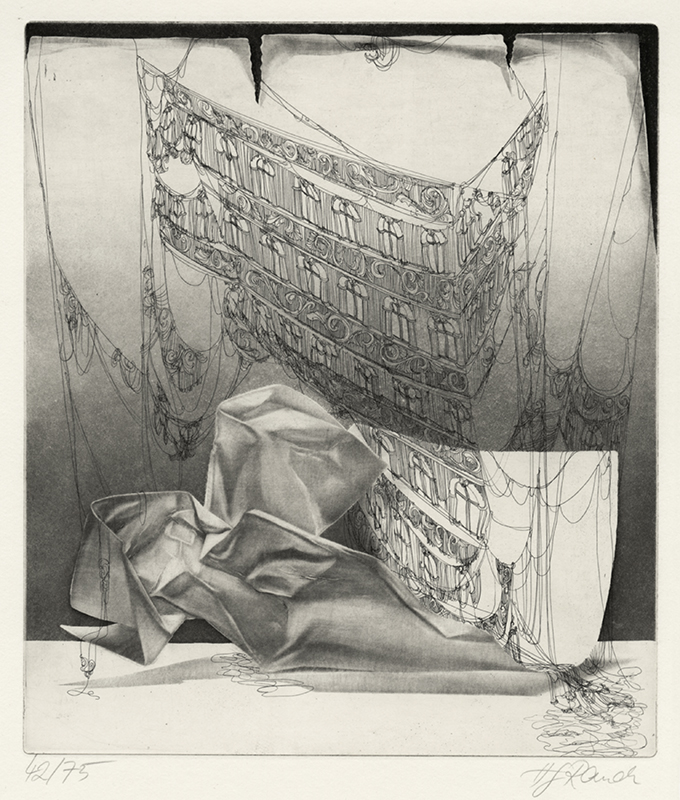Fröhlich Apokalypse V: Das Gerettete Haus (The Happy Apocalypse: The Saved House) is an etching with aquatint and roulette from 1975 by German artist Hans Georg Rauch. It is one of five original prints from The Parchment Suite and is pencil signed and editioned 42/75. Fröhlich Apokalypse V is printed on cream wove German etching paper and the dimensions measure 11-11/16 x 9-3/4 inches platemark.
In this surrealist work, the apocalypse is occurring before our eyes. Upon what appears to be a hanging piece of rent parchment is a depiction of a wall of boxed suites at the opera house. A female torso reclining on the stage is nothing more than draped and folded paper being enveloped by the falling parchment backdrop. This etching is striking its play of light against dark and the juxtaposition of tonal roulette lines against crisp etched lines.
Hans Georg Rauch, illustrator, cartoonist, painter, printmaker, and satirist, was born in Berlin, Germany on 21 June 1939. Rejected by his unwed mother and her family, he was placed in a children’s home operated by the Nazi government. Hans Georg was liberated from hunger and neglect by his aunt who intervened on his behalf and took him to live in the home of his great-grandfather.
Conscripted into the German army, Rauch served from 1958 to 1960. In addition
to combat training, he worked as a military cartoonist. Rauch began his formal
art education at the University of Fine Arts, Hamburg, where he studied from 1961
to 1963, under Professors Thiemann and Bunz. He also learned copperplate
etching from fellow student Wolfgang Werkmeister.
In 1964, Rauch traveled to France for a year of study and the following year he
found work as an illustrator, eventually obtaining commissions from Der
Spiegel, Stern, Look, The Observer, and The New
York Times. In 1969, he married artist Ursula Vorhauer and published his
first book of illustrations "Dessins à regarder de prés"
(Editions Planete, Paris). In 1970, he awarded the Heinrich Zille Prize for socio-critical
drawing, allowing him to travel to United States. Upon his return to Germany, his
first major exhibition was mounted at the Wilhelm Busch Museum in Hanover in
1971. He began working in intaglio printmaking in 1974 and worked almost
exclusively in the medium for several years. He continued to published books
which included Rauch: la majorité
silencieus (1974), Rauch: en masse
(1975), Battle Lines (1977), and Double-Barreled Attack (1977).
A retrospective exhibition of his work took place in 1981 at the Wilhelm Busch Museum and the following year he was included in an exhibition of architectural inspired work sponsored by the Goethe Institute which traveled to Belgium, Canada, China, Hong Kong, the Netherlands, and within the United States.
Hans Georg and Ursula Rauch became deeply involved with the anti-war movement and, in 1983, participated in a protest with various artists in Mutlangen, Germany against NATO, specifically against the decision to station American missiles in Germany. These political actions influenced Rauch's art for the duration of his career.
Rauch continued to receive commissions for cartoons and, in
1987, he received the Cartoonist of the Year award from Le Centre International
de l'Humour Universel, Montreal, Canada.
In 1991, Rauch helped establish an initiative in Worpswede to support the
politically persecuted, including a cafe which would host them. He continued to
travel, work, and exhibit until his sudden death at his home in Worpswede,
Germany on December 23, 1993.



